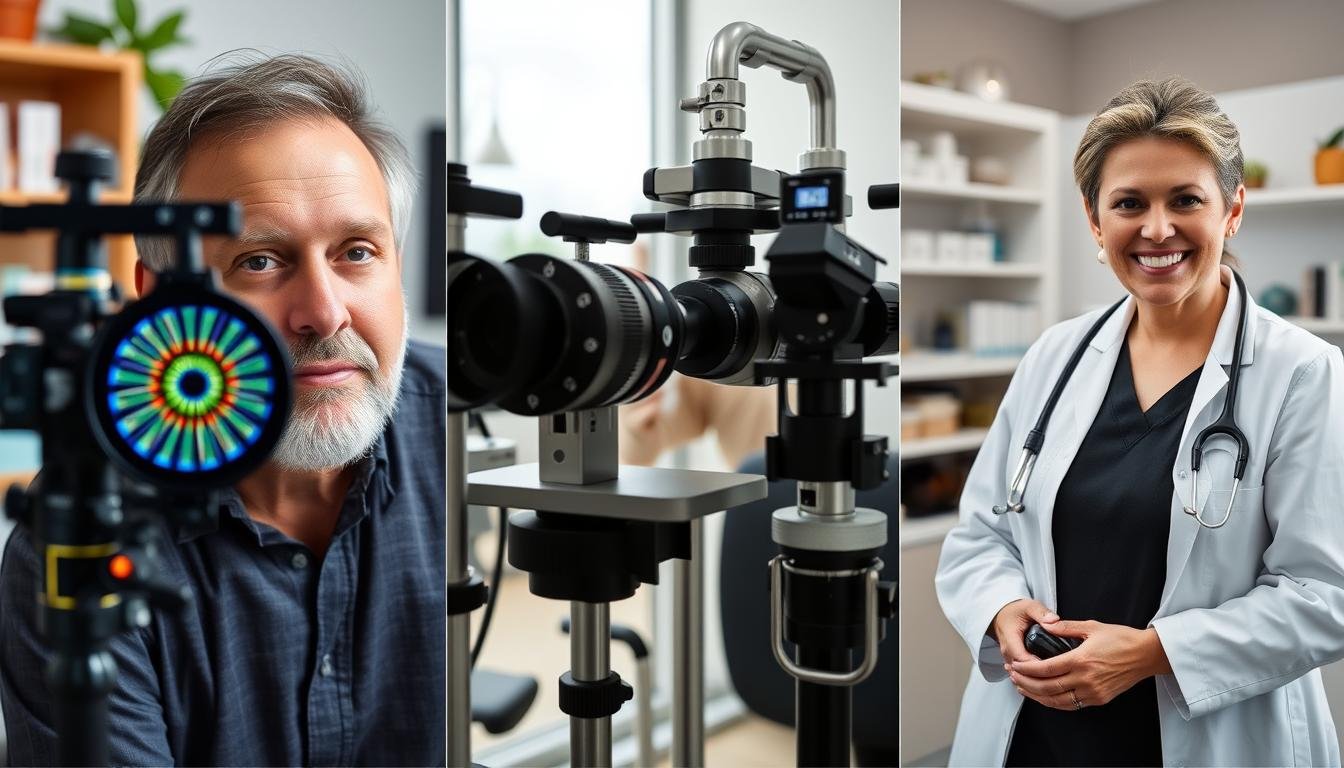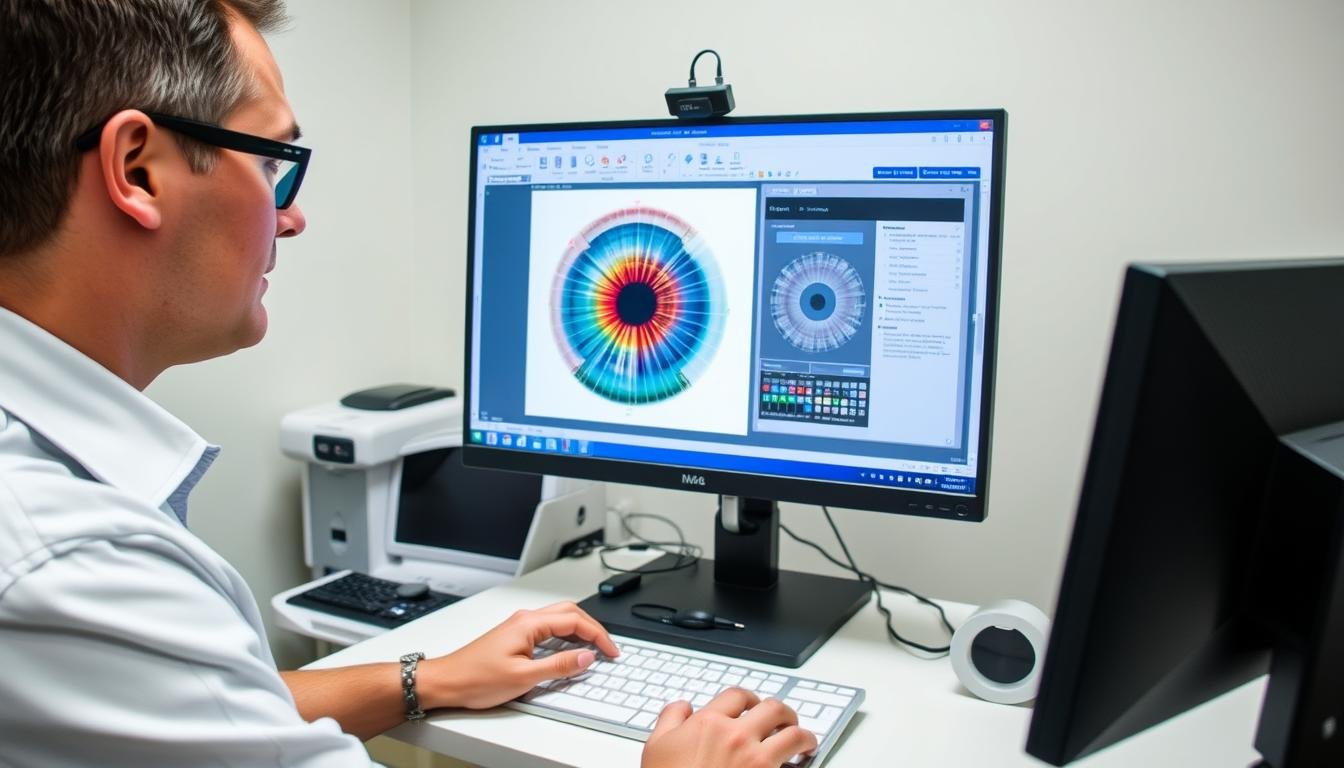The human iris, with its intricate patterns and unique coloration, has long fascinated both medical professionals and alternative health practitioners. Among these specialists, the iridologista stands out as someone who claims to detect health issues through careful examination of the iris—the colored part of your eye. But can these practitioners truly diagnose diseases by looking at your eyes? This comprehensive guide explores the practice of iridology, examining both the claims and the scientific evidence behind this alternative diagnostic method.
O que é um Iridologista?
Um iridologista is a practitioner who specializes in analyzing the patterns, colors, and other characteristics of the iris to evaluate a person’s health status. The practice is based on the theory that each area of the iris corresponds to a specific part of the human body, and changes in these areas can reflect changes in the health of the corresponding body parts.
The foundation of iridology rests on the belief that the iris contains a detailed record of the body’s health history and current condition. Iridologistas use specialized charts that divide the iris into approximately 60 zones, each linked to different organs and systems within the body. By examining these zones, practitioners claim they can identify areas of inflammation, toxin accumulation, and organ weakness.
Maioria iridologistas use tools such as magnifying glasses, specialized cameras, or microscopes to examine the iris in detail. They look for specific signs like color changes, dark spots, rings, and other markings that they interpret as indicators of health problems. The practice is typically considered part of complementary and alternative medicine rather than conventional healthcare.
O Iridologista‘s Role in Disease Diagnosis
The role of an iridologista differs significantly from that of conventional medical practitioners. While medical doctors use laboratory tests, imaging, and physical examinations to diagnose specific diseases, iridologistas claim to identify imbalances and weaknesses that may lead to disease or indicate existing health problems.
Como Iridologistas Claim to Detect Illness
According to iridology principles, the iris reveals information about the body through various signs:
- Color changes in specific zones indicating inflammation or organ stress
- Dark spots suggesting tissue damage or toxin accumulation
- White marks potentially indicating areas of inflammation or immune activity
- Rings around the iris possibly signaling various conditions including high blood pressure
- Structural features like “nerve rings” (circular lines) suggesting nervous system stress
The diagnostic process typically involves an iridologista taking photographs of both irises or examining them directly with magnification. They then compare what they observe with standardized iridology charts to identify potential health concerns. The entire examination is non-invasive and painless.
Common Conditions Analyzed by Iridologistas
Iridologistas claim to identify a wide range of health issues through iris examination, including:
- Digestive disorders and weaknesses
- Inflamação em todo o corpo
- Congestão do sistema linfático
- Nervous system stress
- Desequilíbrios hormonais
- Circulation problems
- Acúmulo de toxinas
- Vitamin and mineral deficiencies
- Organ weaknesses or dysfunction
- Immune system status
Wondering About Your Eye Health?
While iridology offers an alternative perspective, comprehensive eye exams with qualified professionals provide medically validated assessments of your eye health.
Find a Qualified Eye Doctor
Scientific Evidence About Iridologistas
Despite the long history and continued practice of iridology, the scientific community has approached this diagnostic method with considerable skepticism. Understanding the research and medical perspective is crucial for anyone considering iridology.
Peer-Reviewed Studies on Iridology
Several scientific studies have examined the validity of iridology as a diagnostic tool:
“Iridology has shown to be of little benefit to anyone. Patients and therapists should be discouraged from utilizing iridology since it has the potential to cause personal and financial harm.”
– Study published in Archives of Ophthalmology (2000)
A systematic review published in Forsch Komplementärmed (1999) examined four controlled studies and concluded that iridology’s efficacy was not supported by scientific evaluations. Critics point out several fundamental issues with iridology:
- A estrutura da íris é amplamente determinada pela genética e permanece estável ao longo da vida
- Controlled studies have failed to show that iridologists can consistently diagnose known conditions
- There is no established physiological mechanism to explain how internal organs would affect iris appearance
- Different iridology systems use conflicting charts and interpretations
Medical Community’s Stance
The conventional medical community generally does not recognize iridology as a valid diagnostic method. Major medical organizations, including the American Academy of Ophthalmology, do not endorse iridology. Medical professionals raise several concerns:
Medical Concerns About Iridology
- Potential for missed or delayed diagnosis of serious conditions
- False positives leading to unnecessary anxiety and testing
- Lack of standardization in training and practice
- Absence of regulatory oversight in many jurisdictions
- Diversion of resources from evidence-based treatments
It’s worth noting that while the eyes can indeed reveal certain health conditions (such as diabetes, high blood pressure, and autoimmune disorders), these are typically identified through standard ophthalmological examinations rather than iridology techniques.
Myths vs Facts: Iridologista Capabilities
With conflicting claims about what iridologistas can and cannot do, it’s important to separate myths from facts. Here’s a clear comparison based on available evidence:
| Myth | Fact | Evidence |
| Um iridologista can diagnose specific diseases like cancer or diabetes | No controlled studies have demonstrated that iridologists can reliably diagnose specific diseases | Multiple blind studies where iridologists failed to identify patients with known conditions |
| The iris changes throughout life to reflect health changes | The iris structure is largely stable after childhood, with changes primarily related to aging or eye injury | Ophthalmological research on iris stability; use of iris patterns for biometric identification |
| Iridology has been scientifically validated | Most peer-reviewed research has not supported iridology’s diagnostic claims | Systematic reviews in medical journals showing lack of diagnostic accuracy |
| All iridologistas use the same diagnostic system | Multiple competing systems exist with different iris charts and interpretations | Comparison of various iridology texts showing inconsistent organ mappings |
| Iridology is risk-free | Potential risks include missed diagnoses, false positives, and delayed proper treatment | Case reports of patients delaying conventional treatment based on iridology readings |

When to Consult an Iridologista
Despite the lack of scientific validation, some individuals still choose to consult iridologistas as part of their health journey. If you’re considering iridology, understanding when and how to approach it responsibly is important.
Complementary Medicine Considerations
Some people find value in iridology as a complementary approach rather than a replacement for conventional medicine:
- As part of a holistic health assessment alongside conventional medical care
- For general wellness guidance rather than specific disease diagnosis
- When interested in alternative perspectives on health patterns
- As a starting point for discussions about preventive health measures
If you choose to explore iridology, it’s generally recommended to maintain your relationship with conventional healthcare providers and to view iridology as a supplement to, rather than a replacement for, evidence-based medical care.
Red Flags to Watch For
Be cautious of iridologistas who:
Warning Signs in Iridology Practice
- Claim to diagnose specific diseases like cancer or diabetes solely through iris examination
- Recommend abandoning conventional medical treatments
- Sell expensive supplements or treatments based solely on iris readings
- Make guarantees about health outcomes
- Lack transparency about their training and credentials
- Discourage seeking second opinions or conventional medical care
Prioritize Your Health With Evidence-Based Care
While exploring complementary approaches like iridology, ensure you maintain regular check-ups with qualified healthcare professionals.
Schedule a Comprehensive Health Assessment
Como Iridologistas Compare to Other Practitioners
Understanding the differences between iridologistas and other health practitioners can help you make informed decisions about your healthcare options.
| Aspecto | Iridologista | Ophthalmologist | Naturopathic Doctor |
| Educação | Varies widely; no standardized requirements | Medical degree plus specialized training (12+ years) | 4-year accredited naturopathic medical program |
| Licenciamento | Generally unregulated in most countries | Licensed medical doctor with board certification | Licensed in some states/countries |
| Diagnostic Methods | Iris examination | Comprehensive eye exams, medical tests, imaging | Physical exams, lab tests, holistic assessment |
| Treatment Scope | Typically lifestyle and supplement recommendations | Medical and surgical treatments for eye conditions | Natural therapies, lifestyle medicine, some conventional approaches |
| Validação científica | Limited; not supported by most research | Evidence-based practices | Mixed; some approaches evidence-based, others less so |

Enquanto iridologistas focus exclusively on the iris for health assessment, ophthalmologists examine the entire eye and its relationship to overall health. Naturopathic doctors may incorporate some elements of iridology but typically use a broader range of diagnostic tools and approaches.
Estudos de caso: Iridologista Diagnoses
To illustrate how iridology works in practice, let’s examine three hypothetical scenarios that represent common experiences with iridologistas. These cases highlight different outcomes and considerations.
Case 1: Sarah’s Digestive Issues
Situation: Sarah, 42, experienced chronic digestive discomfort for years despite normal test results from her gastroenterologist.
Iridology Assessment: Um iridologista identified markings in the digestive zone of her iris, suggesting inflammation and potential food sensitivities.
Resultado: Sarah eliminated certain foods based on the iridologist’s recommendations while continuing to work with her conventional doctor. She experienced some symptom improvement but later discovered through conventional allergy testing that she had specific food intolerances that partially aligned with the iridology assessment.
Key Takeaway: The iridology session prompted dietary changes that proved helpful, though the specific diagnosis was confirmed through conventional testing.

Case 2: Michael’s Heart Concerns
Situation: Michael, 58, visited an iridologista for a general health assessment with no specific symptoms.
Iridology Assessment: O iridologista identified markings suggesting cardiovascular stress and recommended immediate attention.
Resultado: Michael consulted a cardiologist who found early signs of coronary artery disease requiring medical intervention. The condition might have gone undetected longer without the prompt to seek conventional medical care.
Key Takeaway: While the iridology assessment didn’t diagnose the specific condition, it prompted Michael to seek appropriate medical care that led to early intervention.
Case 3: Emma’s Anxiety
Situation: Emma, 35, experienced chronic anxiety and fatigue. She visited an iridologista after trying various treatments.
Iridology Assessment: O iridologista identified patterns suggesting adrenal fatigue and nervous system stress, recommending specific supplements and lifestyle changes.
Resultado: Emma followed the recommendations for three months with minimal improvement. Later, working with an endocrinologist, she was diagnosed with a thyroid condition that required medical treatment.
Key Takeaway: The iridology assessment missed the underlying medical condition, potentially delaying appropriate treatment.
These case studies illustrate that while iridology may sometimes lead to helpful insights or prompt beneficial medical consultations, it should not replace conventional diagnostic methods, especially for serious health concerns.
Perguntas frequentes sobre Iridologistas
Can an iridologista detect cancer?
There is no scientific evidence supporting the ability of iridologistas to detect cancer through iris examination. Multiple controlled studies have failed to show that iridologists can reliably identify patients with confirmed cancer diagnoses. Cancer detection requires proper medical screening, imaging, and often biopsy for definitive diagnosis. If you have concerns about cancer, consult a licensed medical doctor.
Is iridology FDA-approved?
No, iridology is not FDA-approved as a diagnostic method. The FDA does not recognize iridology as a valid medical diagnostic tool. While the practice itself (examining the iris) is not regulated, any specific claims about diagnosing or treating diseases would fall under FDA scrutiny. The FDA has taken action against some practitioners who made specific disease treatment claims based on iridology.
Quão precisos são iridologistas?
Scientific studies have not demonstrated consistent accuracy in iridology diagnoses. In controlled studies where iridologistas examined photographs of irises from patients with known medical conditions and healthy controls, the practitioners were generally unable to distinguish between them at rates better than chance. Individual experiences with iridology accuracy vary widely, with some people reporting helpful insights while others find the assessments inaccurate or too general.
What training do iridologistas receive?
Training for iridologistas varies widely as there is no standardized educational requirement or licensing in most countries. Some practitioners complete certificate programs ranging from a few days to several months, while others may study at schools of natural medicine where iridology is part of a broader curriculum. Some iridologistas have backgrounds in other health fields such as naturopathy, chiropractic, or traditional Chinese medicine. When considering an iridologista, it’s advisable to inquire about their specific training and credentials.
Conclusion: Making Informed Decisions About Iridology
The practice of iridology presents a fascinating intersection between alternative health approaches and conventional medicine. While iridologistas claim to identify health patterns through iris examination, scientific evidence supporting these claims remains limited.
If you’re considering consulting an iridologista, approach the experience with realistic expectations. View iridology as a potential complement to, rather than a replacement for, conventional healthcare. The most responsible approach is to maintain regular check-ups with licensed medical professionals while exploring complementary options if you choose.
The eyes are indeed windows to certain aspects of health, but the most reliable information comes from comprehensive medical examinations that include standard eye tests performed by qualified eye care professionals. By combining an open mind with critical thinking, you can navigate the world of alternative and conventional healthcare to make choices that best support your overall wellbeing.
Take Charge of Your Eye and Overall Health
Schedule a comprehensive eye examination with a qualified eye care professional to receive evidence-based assessment of your eye health and potential indicators of systemic conditions.
Find a Qualified Eye Doctor Near You
Explore more about alternative diagnostics:











